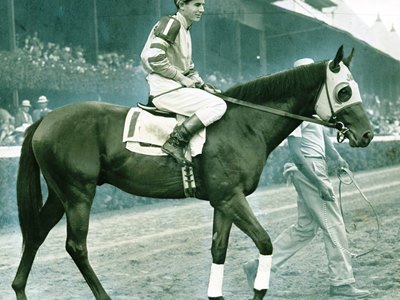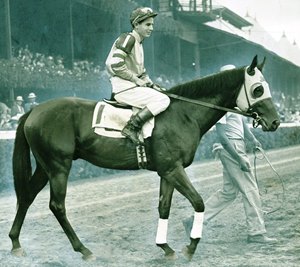BackTrack: A Blue Ribbon Hopeful for Blue Peter


Racing at Saratoga Race Course during the final week had its points of interest, though in general what happened was what was expected to happen.
The Hopeful Stakes confirmed Blue Peter's ranking at the top of the eastern 2-year-olds, and the Saratoga Cup told us only that Snow Goose was a highly capable filly at a distance, which had been more than suspected after she won the Beldame and Ladies' Handicaps last year.
Not exactly in the cards, however, was the defeat of Alablue by Compliance in the Alabama Stakes at mid-week, though really I suppose paying $72,000 for a filly does not necessarily make her win. Alablue had cost $24,000 as a yearling, and by the time of the Ernst dispersal had exactly tripled in value. She ran very well, actually, but the notion here is that a mile and a quarter is a little too much for her. However, she'd switched trainers, and I suppose this is an obstacle for any horse, without reference to the ability of the trainers involved.
Compliance, which had cost the racing partnership of Frank Heller and Benjamin O'Shea only $4,500 as a yearling, was giving Alablue four pounds in the Alabama, and she gave her more pressure in the stretch than the Blue Larkspur filly could stand. Her next opportunity in the New York area comes at Aqueduct on closing day, September 11, in the nine-furlong Beldame Handicap. Alablue is in this too, as well as such older mares as Gallorette, Harmonica, and Snow Goose. In the last two years the Beldame has had to be split, Gallorette won one of the 1946 divisions, Snow Goose one of those of 1947.
Miss Grillo, which was second to But Why Not in the other division last year, is another 1948 eligible. Her race in the Saratoga Cup did not prove much to me, for there was no pace except what Miss Grillo set herself, and that isn't her style. She looks in fine condition, and with pace ahead of her may give a better account of herself.
For the rest, Saratoga showed no signs of fatal decay. The actual drop—about 3% in attendance and about 81/2% in betting—was considerably less than that recorded at many tracks about whose future no one is concerned. Had it not been for the miserable hot weather of the last four days, there might have been no drop at all in attendance, for the decrease was only a little more than 11,000, and up to the beginning of the heat wave, the track was running almost level with last year's figures. Most of the drop came during the first week, which suggests that Monmouth Park was cutting in more than I would have thought.
Saratoga doesn't draw many daily commuters—it's an overall trip of about 14 hours from New York—but apparently a fair number of people stayed with Monmouth until it closed, and then moved up to Saratoga.
Anyway, things began to pick up after the first week, and the drop was less than Saratoga's best friends hoped for.

Stakes story
At this writing, Blue Peter appears to be the leader among the eastern 2-year-olds. The Hopeful Stakes, his most important victory financially of his short career, was his sixth consecutive win, his fifth consecutive stakes victory, and his seventh triumph in nine starts.
In his first stakes effort he was third to Eternal World in the Youthful at Jamaica on May 1. Then he started his winning streak: a victory over the stakes-winning Noble Impulse in an overnight race, and triumphs in the William Penn, Garden State and Sapling Stakes, and the Saratoga Special, followed by the Hopeful victory.
Without checking the records very closely, it may be presumed that he is the leading money-winning 2-year-old of 1948. His earnings of $100,775 make him the fifth winner of $100,000 for War Admiral, his sire. The others are Busher, War Date, War Jeep, and Bric a Bac. He is the first for his breeder, Joseph M. Roebling, of New Jersey. His trainer, Andy Schuttinger, won the Hopeful in 1918 on Eternal, and in 1920 on Leonardo 2nd.
